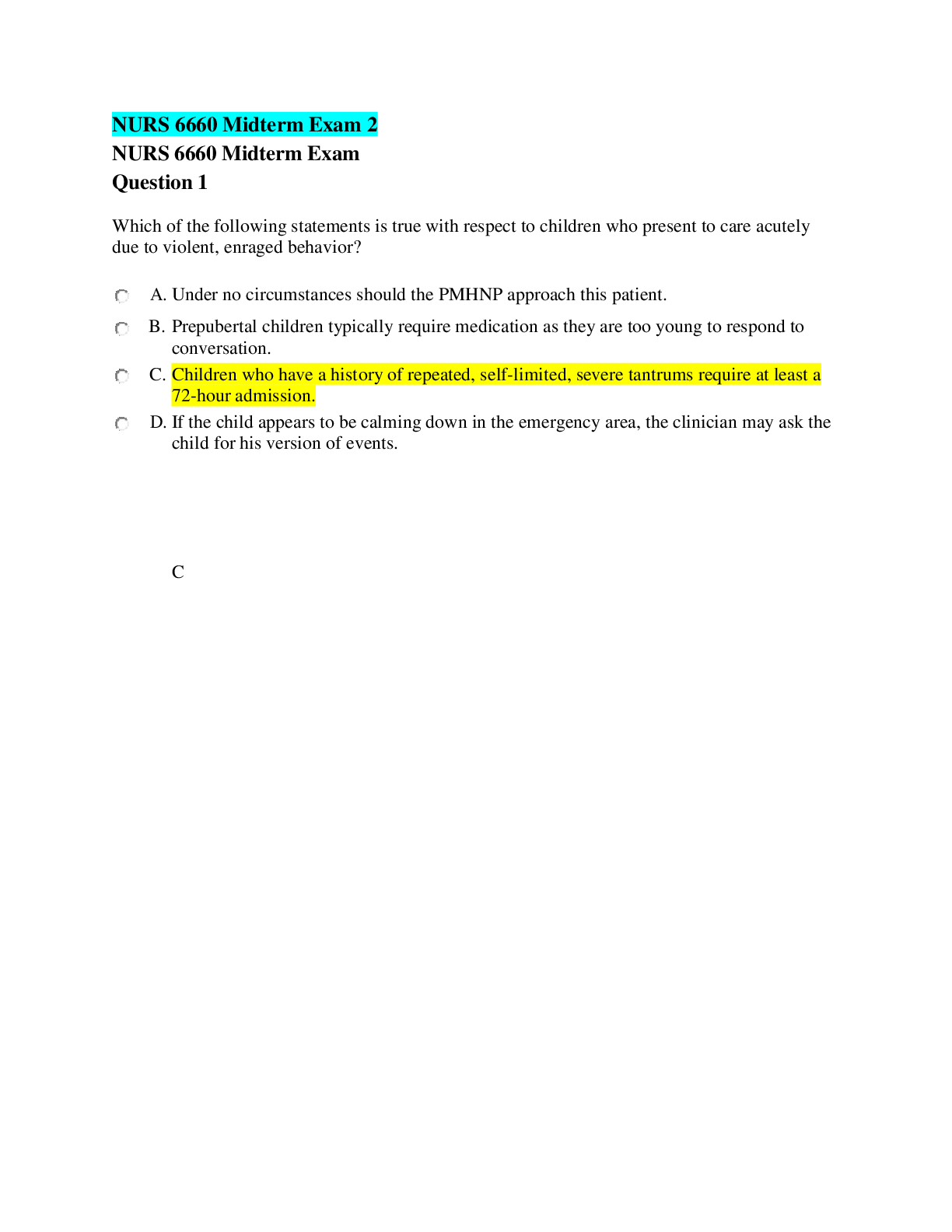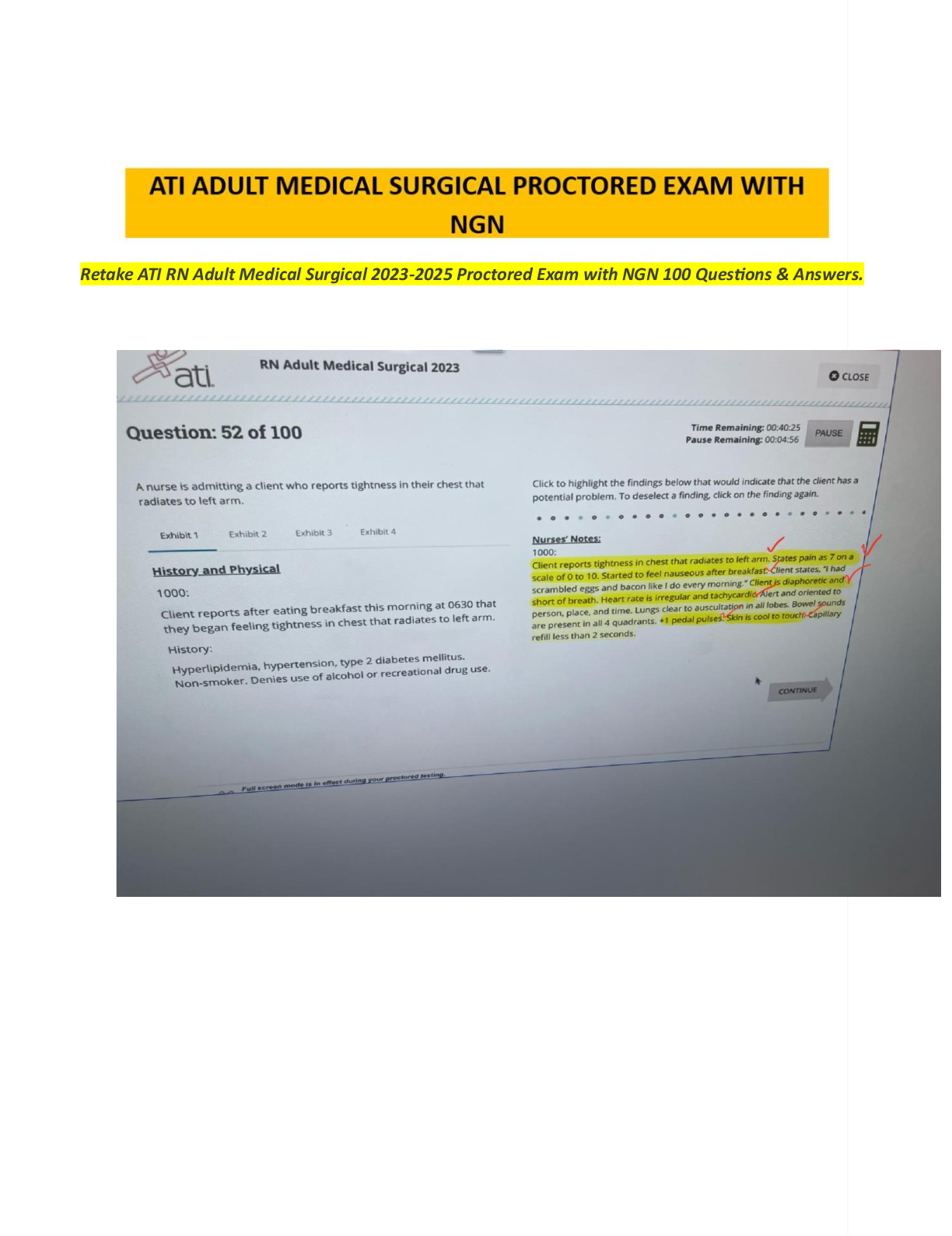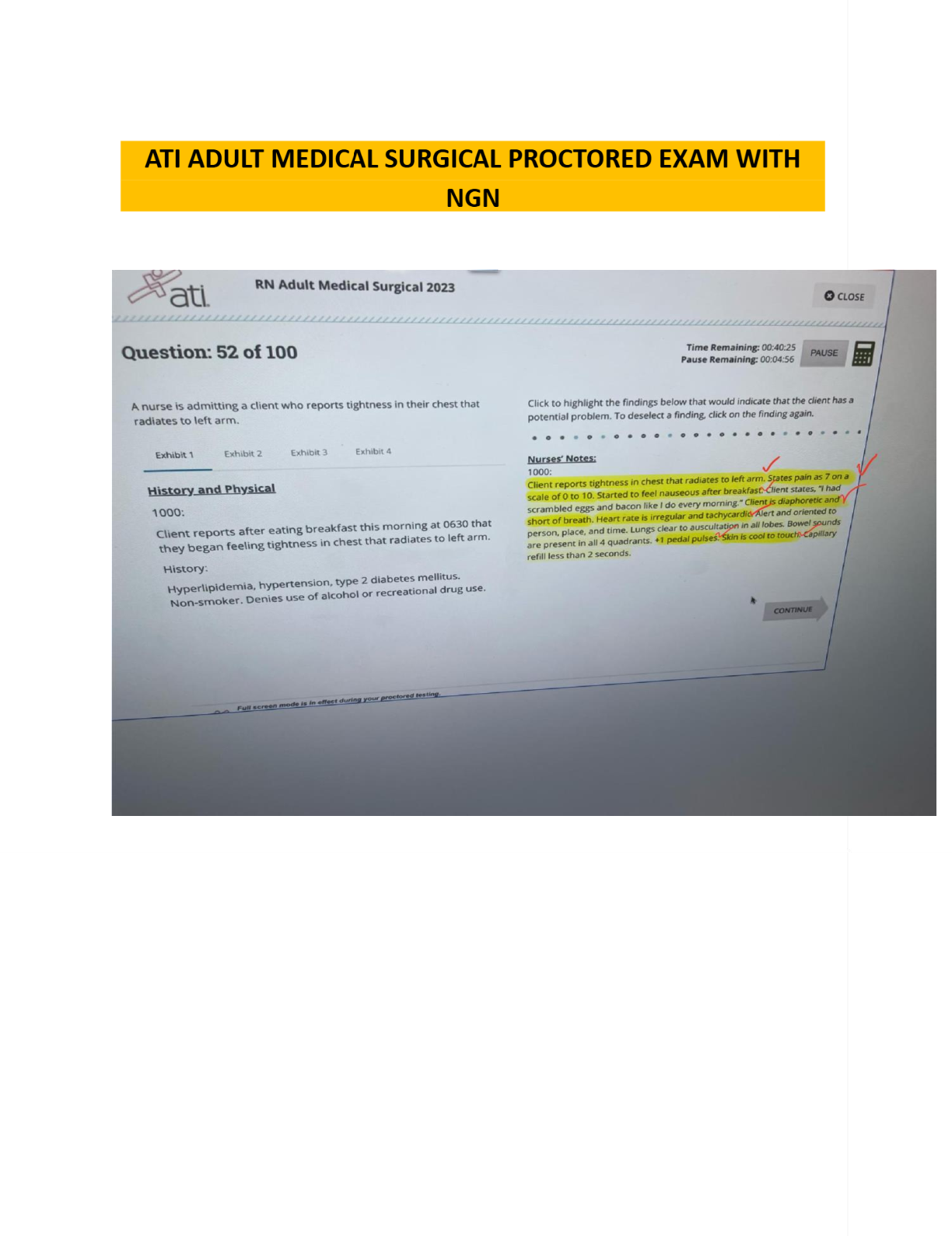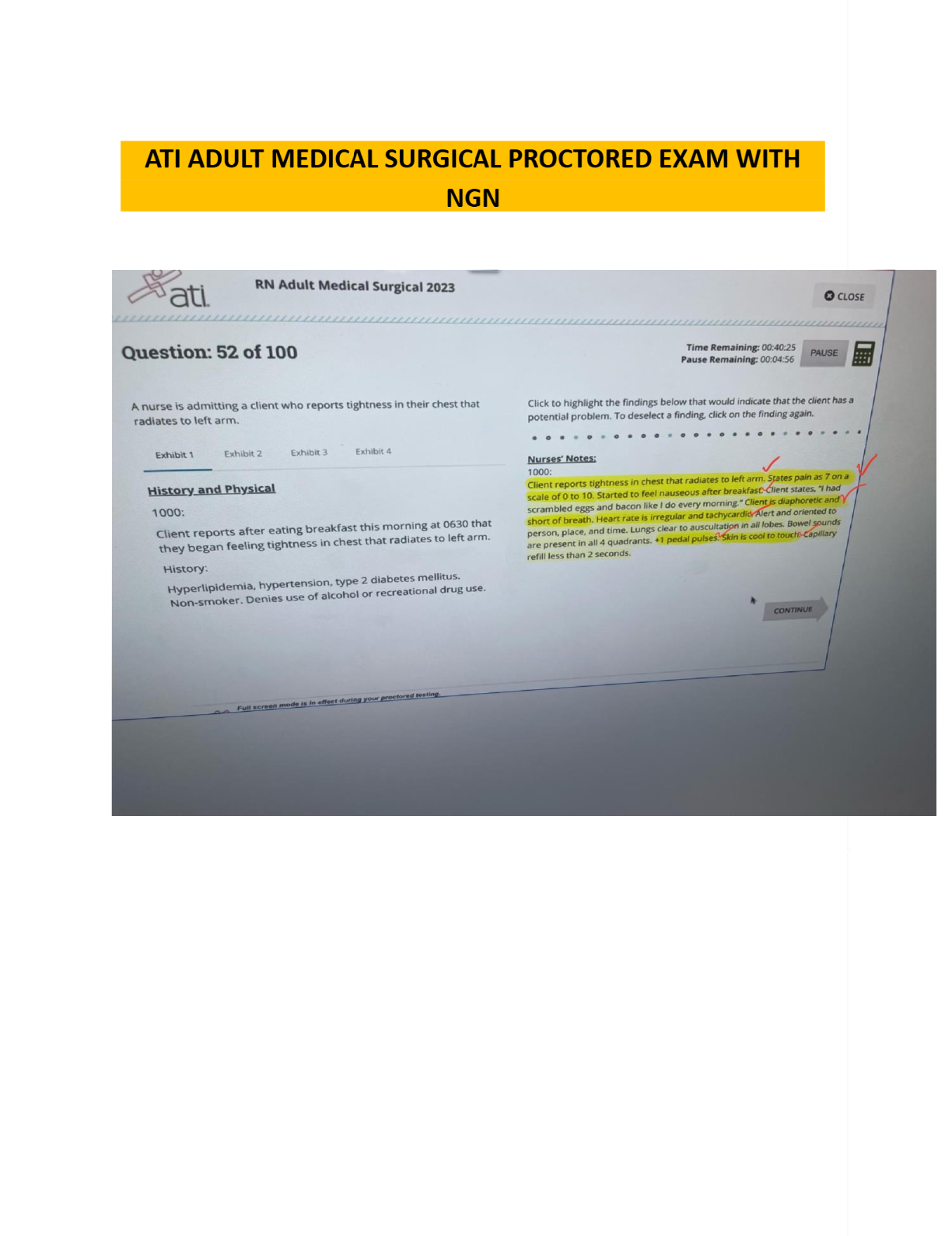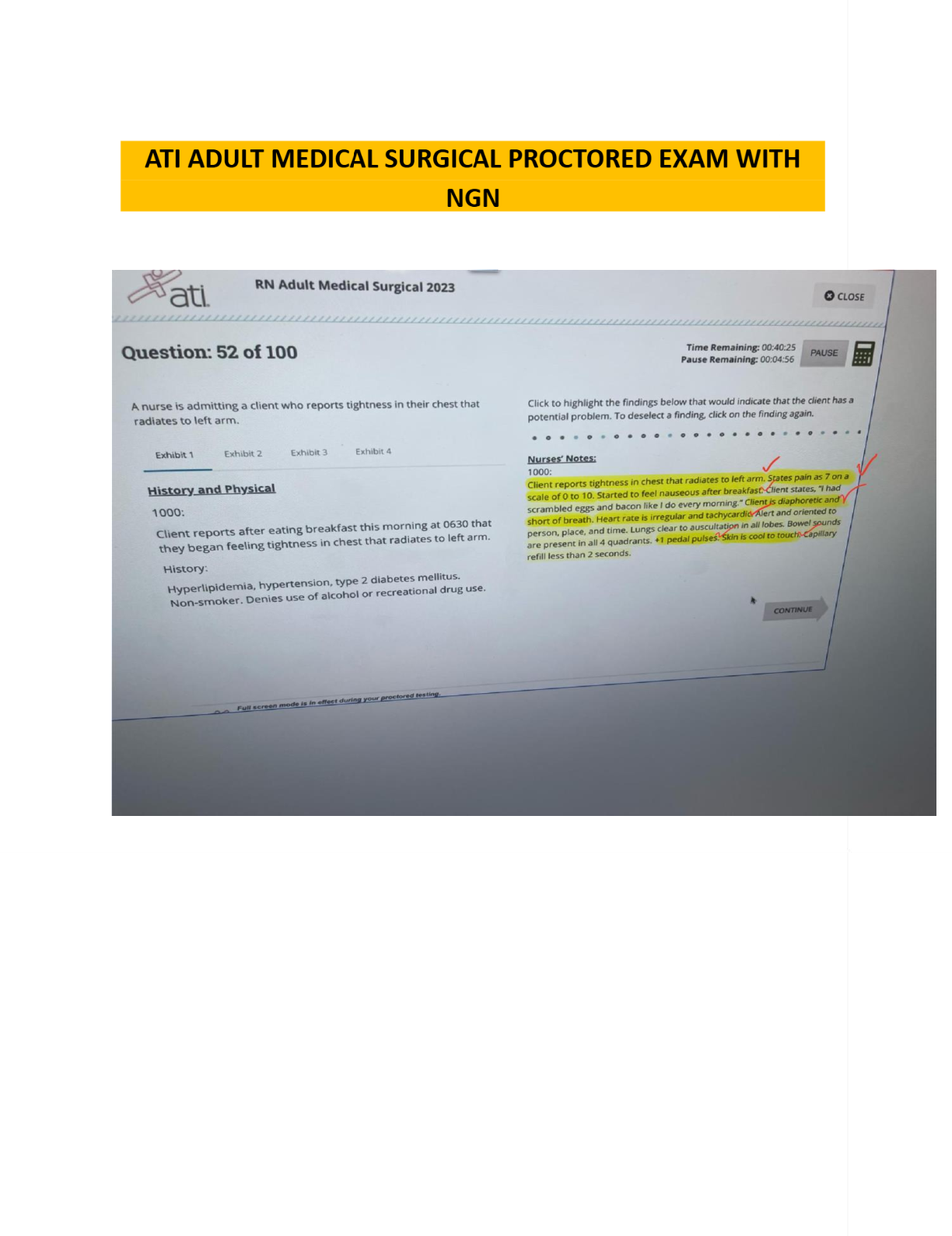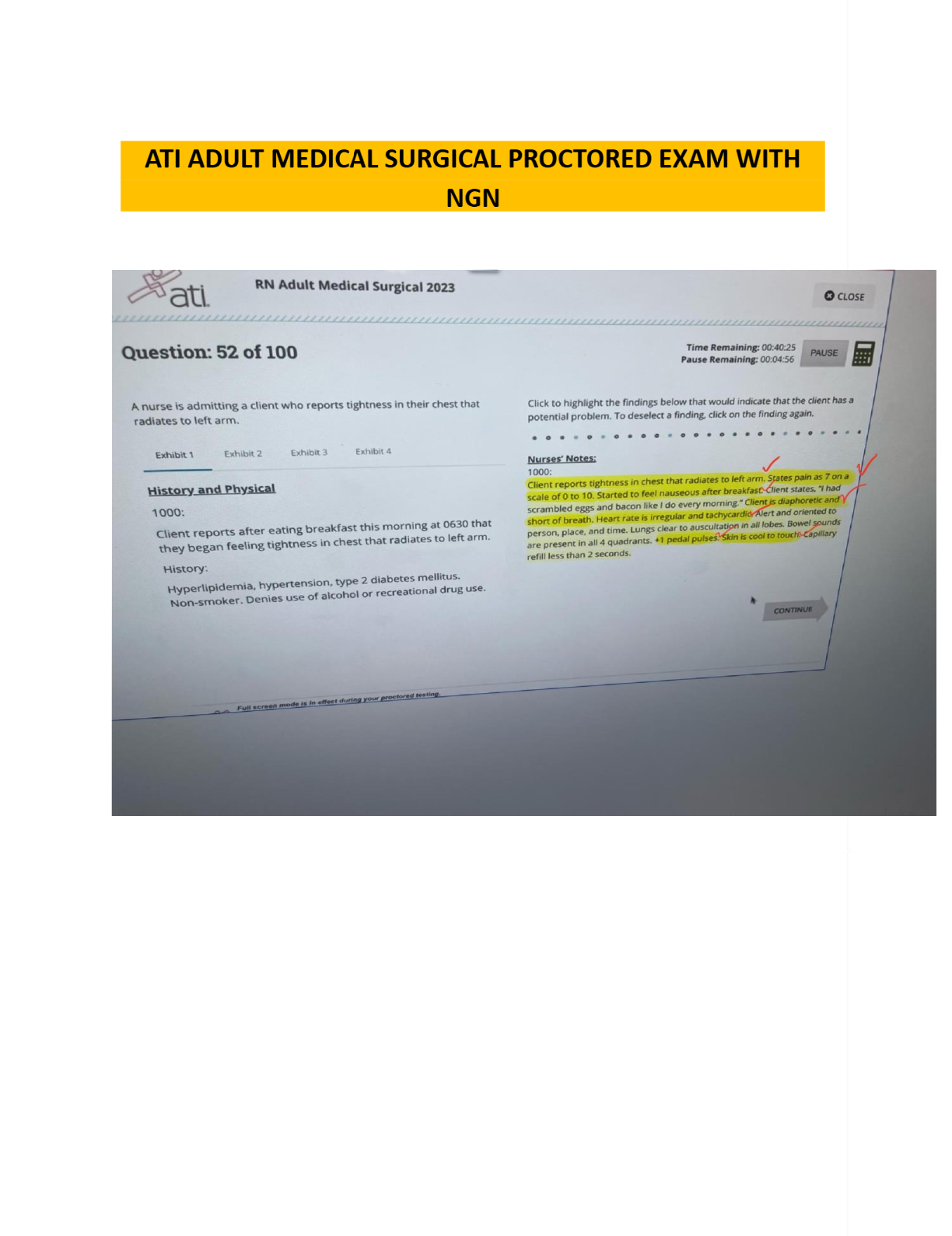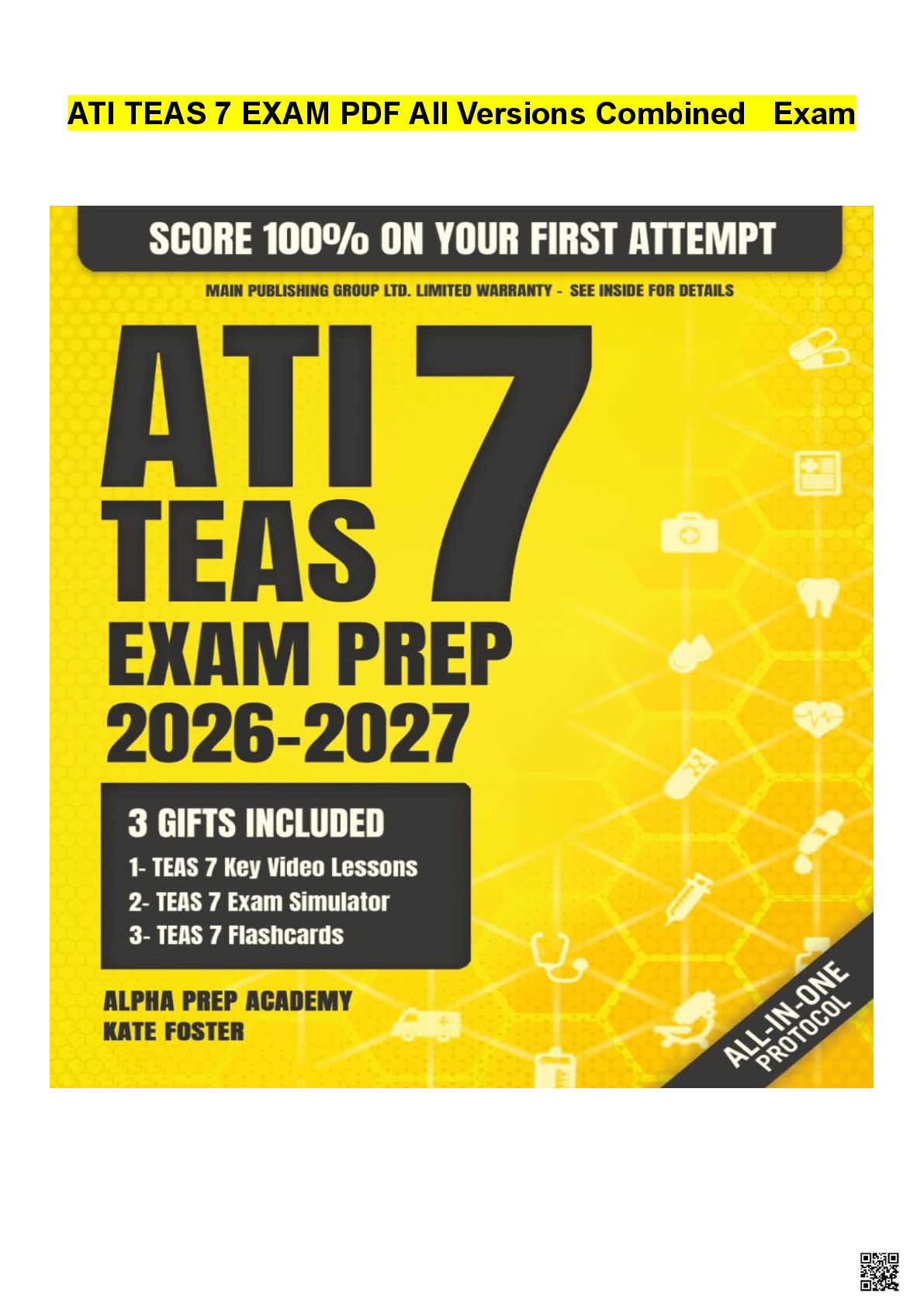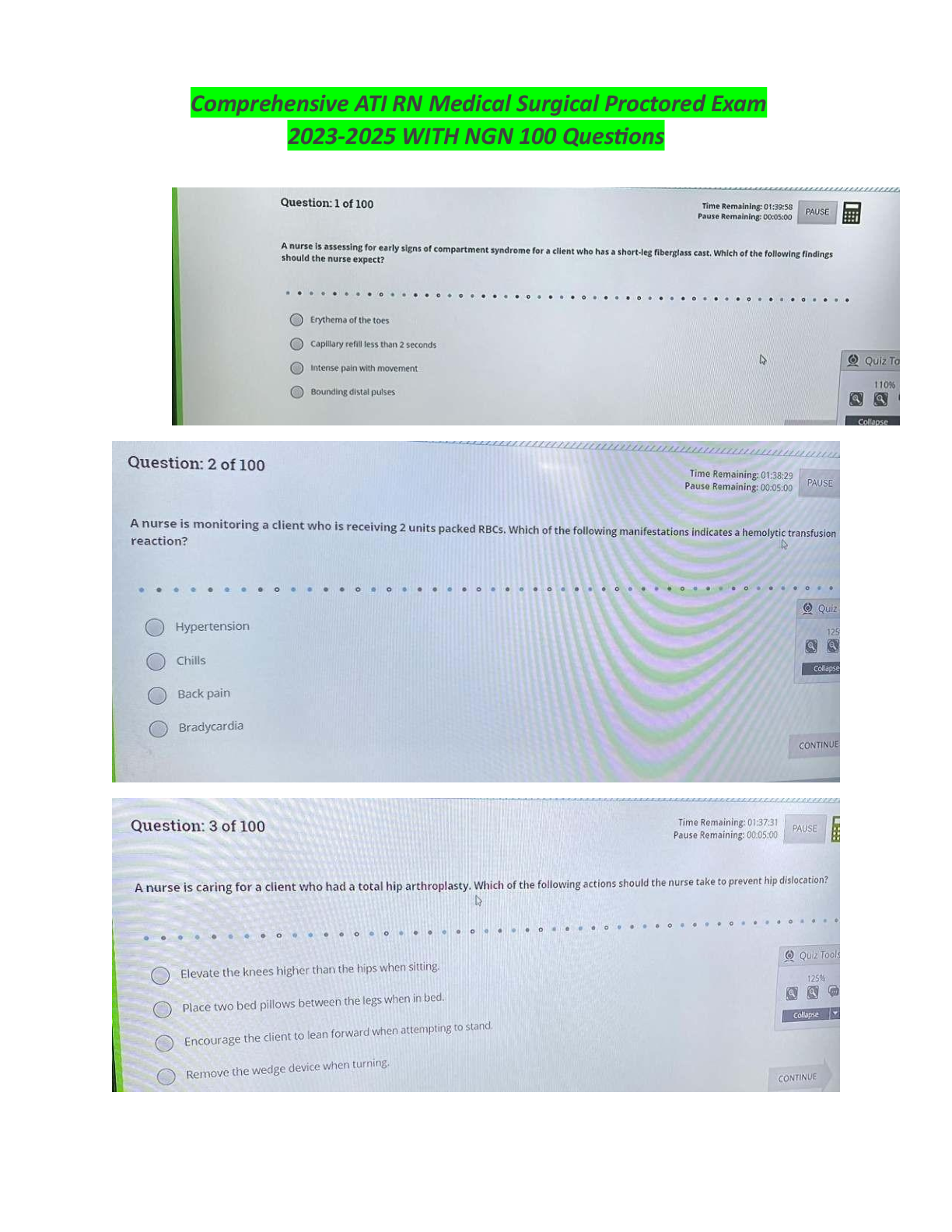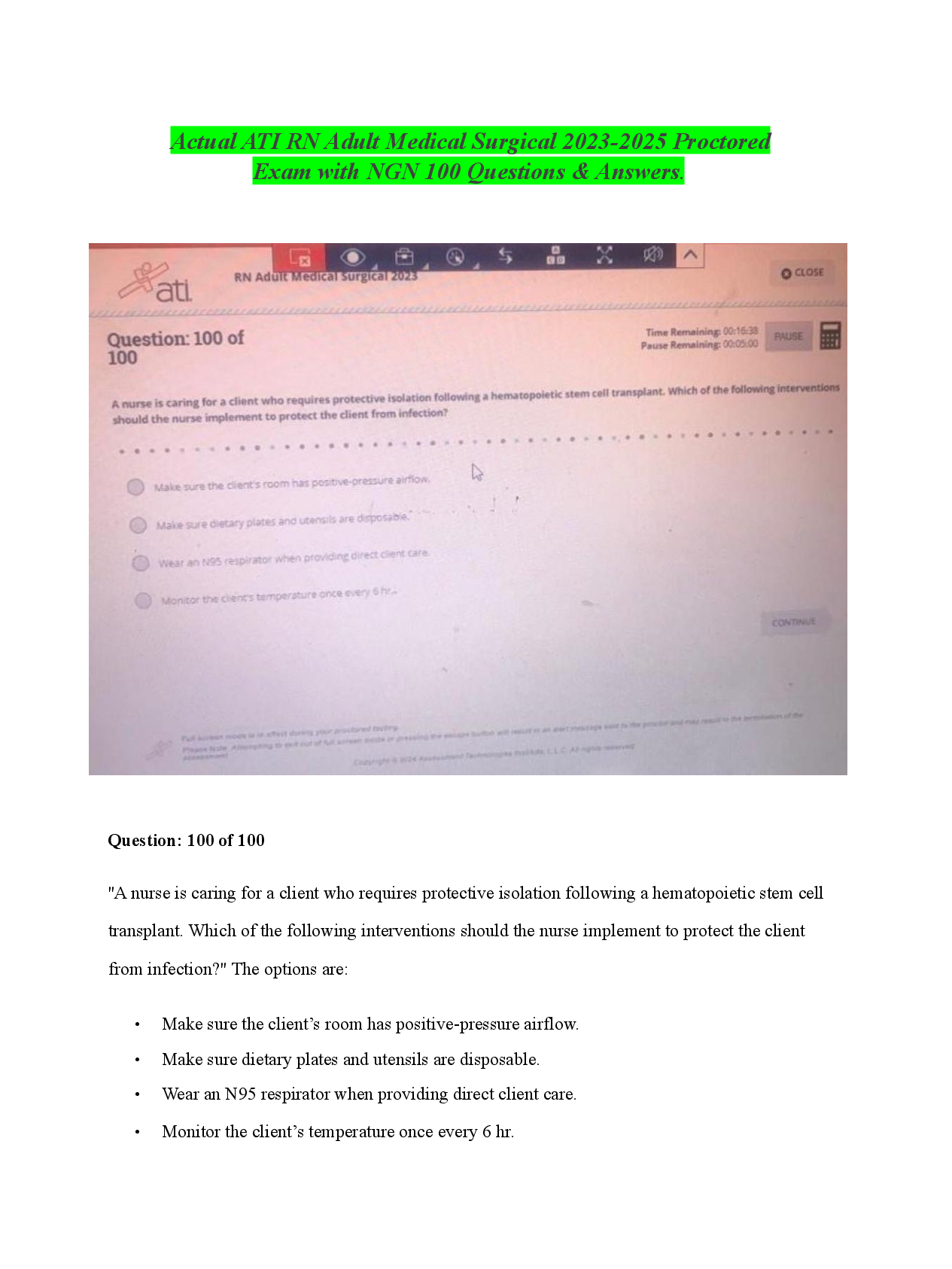Biology > EXAM > BIOS 256 Final Exam Multiple Questions & Answers, Complete solution (all Answers Correct). (All)
BIOS 256 Final Exam Multiple Questions & Answers, Complete solution (all Answers Correct).
Document Content and Description Below
BIOS 256 Final Exam (Questions & Answers) Multiple Choice 1. Question: The urinary system does all of the following, EXCEPT it 2. Question: Conical structures that are located in the renal medulla ... are called 3. Question: The region known as the macula densa is part of 4. Question: The cells of the macula densa and the juxtaglomerular cells form the 5. Question: A glomerulus is 6. Question: The following is a list of the blood vessels that carry blood to the kidney. 7. Question: The process of filtration is driven by 8. Question: The mechanisms for maintaining the solute concentration gradient in the renal medulla require 9. Question: Which of the following is greater? 10. Question: The antidiuretic hormone 11. Question: In the loop of Henle 12. Question: Which hormone stimulates the thirst mechanism most? 13. Question: All of the following are components of ECF, except 14. Question: Which hormone plays a role in determining the rate of sodium absorption and potassium loss? 15. Question: You are caring for a patient who has been vomiting and having diarrhea for the past five days. You suspect that his electrolyte levels are 16. Question: Which hormone affects the osmotic concentration of urine without affecting any ion levels? 17. Question: The most common problems with electrolyte balance are caused by an imbalance between gains and losses of 18. Question: The higher the plasma concentration of aldosterone, the more efficiently the kidney will 19. Question: Angiotensin II produces a coordinated elevation in the ECF volume by 20. Question: Renal failure can result in 21. Question: Intracellular fluid (ICF) is found in 22. Question: The principal cation in intracellular fluid is 23. Question: When water is lost, but electrolytes are retained 24. Question: Consuming a meal high in salt will 25. Question: Aldosterone 26. Question: When the level of sodium ion in extracellular fluid decreases, 27. Question: Excess potassium ion is …… from the body by 28. Question: The amount of potassium …… by the kidneys is ……. by 29. Question: Calcium reabsorption by the kidneys is promoted by the hormone 30. Question: Each of the following statements concerning chloride ions is true, except that 31. Question: The primary role of the carbonic acid–bicarbonate buffer system is to 32. Question: Acidosis can cause all of the following, except 33. Question: Hypoventilation would cause 34. Question: In response to respiratory alkalosis, the 35. Question: Prolonged vomiting can result in 36. Question: A person with emphysema will exhibit signs of 37. Question: A person with chronic diabetes will exhibit signs of 38. Question: A person who chronically consumes large amounts of antacids to settle an upset stomach may risk 39. Question: To survive, humans must maintain a normal volume and composition of 40. Question: A _____ acid is an acid that can leave solution and enter the atmosphere 41. Question: The reproductive system 42. Question: Projections of the tunica albuginea, known as septae, divide the testis into 43. Question: Straight tubules originate at the seminiferous tubules and form a maze of passageways called the 44. Question: The spermatic cord is 45. Question: Interstitial cells produce 46. Question: The sustentacular cells of the seminiferous tubules do all of the following, except that they 47. Question: Sperm production occurs in the 48. Question: Sperm develop from stem cells called 49. Question: As developing sperm cells begin the process of meiosis, they become 50. Question: The cells that are formed at the end of ….. are called 51. Question: Sperm are …… along the ductus deferens by 52. Question: The following is a list of structures of the male reproductive tract. 53. Question: The structure that carries sperm from the seminal vesicle to the urethra is the 54. Question: The tubular structure that produces a secretion that contains fructose, prostaglandins, and fibrinogen is the 55. Question: The structure that surrounds the urethra and produces an alkaline secretion is the 56. Question: Seminal fluid contains all of the following, EXCEPT 57. Question: The male organ of copulation is the 58. Question: The portion of the penis that surrounds the external urethral meatus is the 59. Question: The erectile tissue that surrounds the urethra is the 60. Question: The role of the pituitary hormone follicle-stimulating hormone in males is to 61. Question: The pituitary hormone that stimulates the interstitial cells to secrete testosterone is 62. Question: The broad ligament is 63. Question: The organ that provides mechanical protection and nutritional support for the developing embryo is the 64. Question: The round ligaments extend from the 65. Question: The muscular layer of the uterus is the 66. Question: Each of the following statements concerning oogenesis is true, EXCEPT that 67. Question: The surge in luteinizing hormone that occurs during the middle of the ovarian cycle triggers 68. Question: A rise in the blood levels of follicle-stimulating hormone at the beginning of the ovarian cycle is responsible for 69. Question: During the proliferative phase of the menstrual cycle, 70. Question: During the secretory phase of the menstrual cycle 71. Question: During the menses 72. Question: All of the following are true of the vagina, EXCEPT that it 73. Question: In the mammary gland, milk production occurs in the 74. Question: The clitoris is 75. Question: The principal hormone(s) secreted by the corpus luteum is/are 76. Question: Menstruation is ……. by a drop in the levels of 77. Question: The developing follicle cells secrete 78. Question: The hormone estradiol does all of the following, EXCEPT that it 79. Question: All of the following occur at puberty in both sexes, EXCEPT that 80. Question: The _____ is the inferior portion of the uterus that extends from the isthmus to the vagina 81. Question: Which muscle draws the scrotal sac close to the body to control scrotal temperature? 82. Question: During which stage of spermatogenesis do the cells begin meiosis? 83. Question: The primary oocyte and its follicle cell form in the 84. Question: DNA replicates during 85. Question: Sustentacular cells contain or function in all of the following, EXCEPT 86. Question: Which is the function of the ovaries? 87. Question: Where does oocyte growth and meiosis I occur? 88. Question: The completion of meiosis in males produces four spermatids, each containing 89. Question: Testosterone and other androgens are …… by the 90. Question: The solid ball of cells that is formed after several rounds of cell division following fertilization is called a 91. Question: The hormone that increases the flexibility of the symphysis pubis and causes dilation of the cervix during pregnancy is 92. Question: In _____, implantation occurs somewhere other than in the uterus 93. Question: Human chorionic somatomammotropin will not …. converted to active status without [Show More]
Last updated: 3 years ago
Preview 1 out of 12 pages

Buy this document to get the full access instantly
Instant Download Access after purchase
Buy NowInstant download
We Accept:

Reviews( 0 )
$8.00
Can't find what you want? Try our AI powered Search
Document information
Connected school, study & course
About the document
Uploaded On
Mar 25, 2020
Number of pages
12
Written in
All
Additional information
This document has been written for:
Uploaded
Mar 25, 2020
Downloads
0
Views
269




